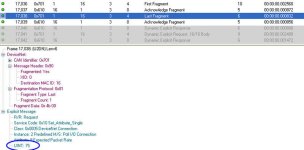LogicalControls
Member
written customer micro-controller software that initiates a Polled connection to a devicenet master. The Poll response is fragmented over 8 messages and the problem is that the each message is being transmitted approximately every 1.1 milliseconds, which is to fast for the micro I am using. Subsequently I miss, 2 out of 3 messages from the Poll response, but eventually all the data is finally received after a delay between 2 and 5 seconds.
Anyhow the question is can or how do you control the poll response message timing. I can not find anything in the Devicenet protocol or in the manual for the slave device that directly addresses this question. At this time my best guess is that it is related to the "expected packet rate", simply divide the packet rate by the number of messages in the poll response to get the maximum interval between messages. But I was hoping someone could confirm this is how devicenet works. Thanks
Scott Jones
Anyhow the question is can or how do you control the poll response message timing. I can not find anything in the Devicenet protocol or in the manual for the slave device that directly addresses this question. At this time my best guess is that it is related to the "expected packet rate", simply divide the packet rate by the number of messages in the poll response to get the maximum interval between messages. But I was hoping someone could confirm this is how devicenet works. Thanks
Scott Jones





